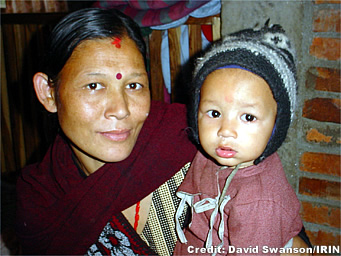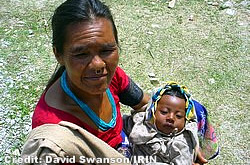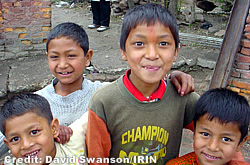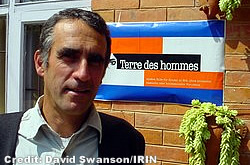 |
| Development |
| Development in Nepal: Reports on Food Crisis |
|
|
|
|
|
 |
| Focus on malnutrition and the conflict |
KATHMANDU, 4 May 2006
For Goma Shrestha, providing for her children's daily needs is more than a challenge; it's impossible. Despite the fact that her one-year old son's normal body weight should be 10 kg, Babu Shristha, weighs just eight kg, leaving this impoverished mother-of-four in a quandary over what to do.
 |
|
| THE PROBLEM OF MALNUTRITION |
 |
|
"The conflict is exacerbating malnutrition levels. Definitely, we can prove it," said Reinhard Fichtl, country representative for the international NGO Terre des hommes Foundation, which has been working closely with thousands of impoverished mothers and their children in the country for years.
"We are doing this since 2001 and it seems that the number of needy families is increasing," he said, citing an earlier study the NGO had conducted.
According to findings published in its "Nutritional Status of Children Victims of the Armed Conflict in Nepal", a 2005 survey of internally displaced children in Banke district in midwestern Nepal, of the 264 children under the age of three surveyed from four project locations where IDPs families were living, 59 percent were found to be underweight and up to 15.9 percent wasted.
The
highest number of malnourished children were found in the Rajhena internally
displaced persons (IDPs) camp (73 percent) near the southern border
city of Nepalganj. At least 55 percent were suffering from common illnesses
like diahhorea, fever, acute respiratory infections and skin ailments,
the report said, adding malnutrition rates and prevalence of common illnesses
(82 percent) in small children, especially in Rajhena, could be considered
as worrying.
| THE HISTORY OF MALNUTRITION |
 |
|
During this critical age in a child's development, a large number of calories are needed to support the child's growth, otherwise the child may be permanently stunted - a condition generally determined in the first two years of life - and largely evident in the country's population.
The United Nations Fund for Children (UNICEF) reports that 50 percent of children in the mountain kingdom are stunted, referring to those children as short for their age, with that figure rising to up to 80 percent in mountain areas.
"Malnutrition is one of the most challenging tasks in a country like Nepal and its worsening because of the conflict," Fichtl repeated.
And with little improvement over the past three decades, the veteran aid worker might just be right.
"We
now even have the problem that many donors don't want to fund malnutrition
projects because the success rates are so low," he said, emphasising the
need for patience and many years before real results can be achieved.
| THE GOVERNMENT'S POSITION |
 |
|
But that may be premature. Malnutrition among children in Nepal remains a major cause of child mortality, claiming around 50,000 children each year.
"Apart from malnutrition being the underlying cause of child mortality, it impacts on child growth and mental development, thereby affecting social and economic development," Pradhan was quoted as saying, a sentiment echoed by his colleagues.
Sharda Pandey, chief of the Nutrition Section of the Child Health Division, said malnutrition had proven a multi-dimensional problem, related to education, economy and levels of awareness. "Good nutrition is a fundamental right for all, for survival, growth and development," she added.
Sadly, however, that is a right many still do not have; a fact that should make those in the donor community stand up and notice, aid workers say.
"It's absolutely unacceptable that we have malnutrition levels above 50 percent. And in Nepal, it seems to be accepted," Fichtl argued, noting many donors still failed to understand the problem's complexity.
Nutrition programmes have to be social programmes which are interrelated to the empowerment of women in marginalised communities to increase their level of decision making at home, access to food, along with access to money and resources, he explained.
According to another study by the NGO two years earlier, the primary cause of malnutrition amongst children in Nepal is the stress of mothers, many of whom have to work or lack enough time to concentrate on the child's actual needs.
"Very often they do not realise how much attention a small baby needs and they simply forget to feed it," Fichtl explained, stressing the fact that malnutrition was not always related to food shortage.
Most of the malnourished children cited in the NGO's 2005 report came from female-headed families and knowledge among mothers on the feeding practices of small children seemed limited.
Moreover, only one of the 18 mothers surveyed said she fed her child five times a day while others fed much less. Whatever little food they had access to, many mothers were not aware that these very food items could be prepared nutritiously for their children, while none of the mothers prepared separate food for their children.
Indeed, at least in Nepal, malnutrition is very often related to stress symptoms brought upon the family by the ongoing conflict, Fichtl added, particularly with regard to displacement or the absence of a husband or male family member who may have migrated abroad for work.
Upwards of 80 percent of all children surveyed below the age of three at the Rajhena IDP camp were sick, caught up in the traditional conflict scenario in which disease causes malnutrition and malnutrition causes disease, the report noted.
"So many children are caught in this vicious cycle and unfortunately many people, including many NGOs, don't see the relationship between the conflict and malnutrition," Fichtl asserted.
Terre des hommes country representative, Richard Fichtl, says the conflict is making malnutrition levels even higher
Following a recent visit to the mid-western districts, he was appalled by the lack of health posts in the area, saying: "There is nothing. Outside the district headquarters, health posts were nonfunctional."
"When
we talk about malnutrition, it needs a constant interaction between health
workers and affected families. That system has gone and it's very difficult
to reestablish such a system in the framework of health because you need
health workers, you need coverage, you need social interventions - all
of which are particularly difficult in Maoist-controlled areas," he further
explained.
| A NEED FOR FURTHER ASSESSMENT |
Others, meanwhile, are less convinced that malnutrition levels as a result of the conflict are actually rising. "Malnutrition is a disaster in Nepal and has been forever," Po Blomquist, chief of UNICEF's nutrition and care section in Kathmandu, said, noting that although one would think that the situation is deteriorating further, they had not seen any conclusive evidence of that happening.
If body weight or body wasting were used as indicators, the figures could be misleading, Blomquist said, depending on the season. "Trends such as stunting are a better indicator. Stunting does not change with the time of the year, while wasting goes up and down," he clarified.
Moreover, women in Nepal are often very short already or malnourished during birth which in turns results in babies having a low birth weight as well - or who inherit malnutrition.
"This is not to say that there might not be localised examples in which malnutrition rates had worsened because of the conflict. [But] we don't see anything strongly suggesting that the rates are increasing," the UNICEF official stressed.

|
|
|
| Source:IRIN 2006 Copyright © UN Office for the Coordination of Humanitarian Affairs 2006 [ This report does not necessarily reflect the views of the United Nations] |
Integrated Regional Information Networks (IRIN), part of the UN Office for the Coordination of Humanitarian Affairs (OCHA).
| more information |
|
| Links |
| External link |
| UNFPA | OCHA | IRIN News |
| SNV Netherlands | UNDP | WFP | UNICEF |
| Integrated Regional Information Networks (IRIN) | IRIN News |
 |
|
|